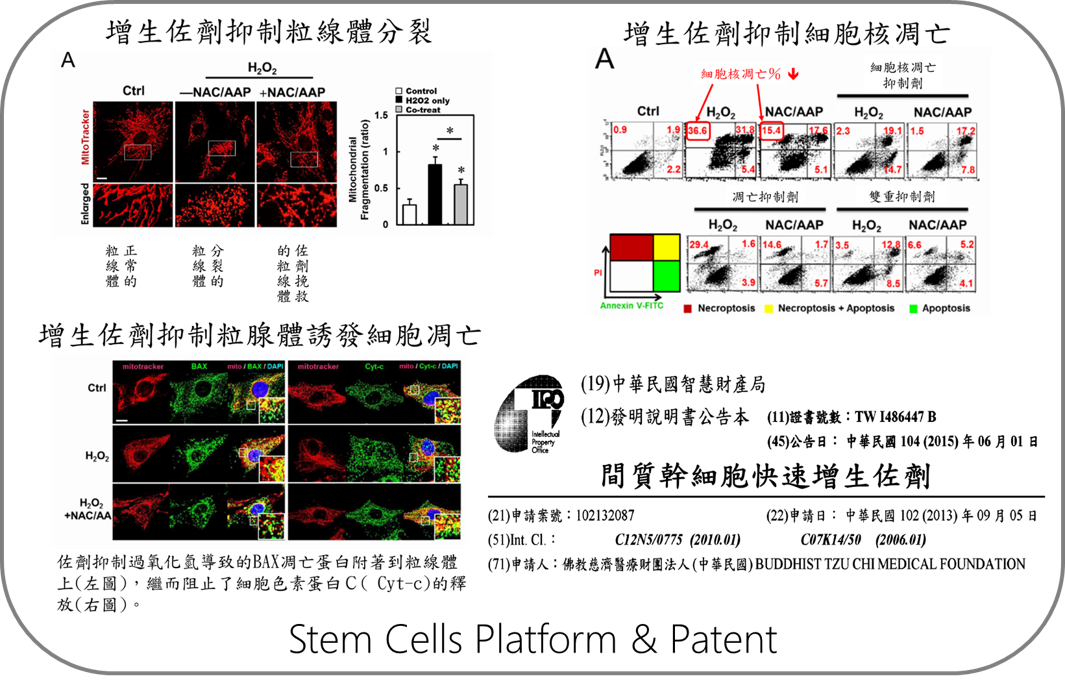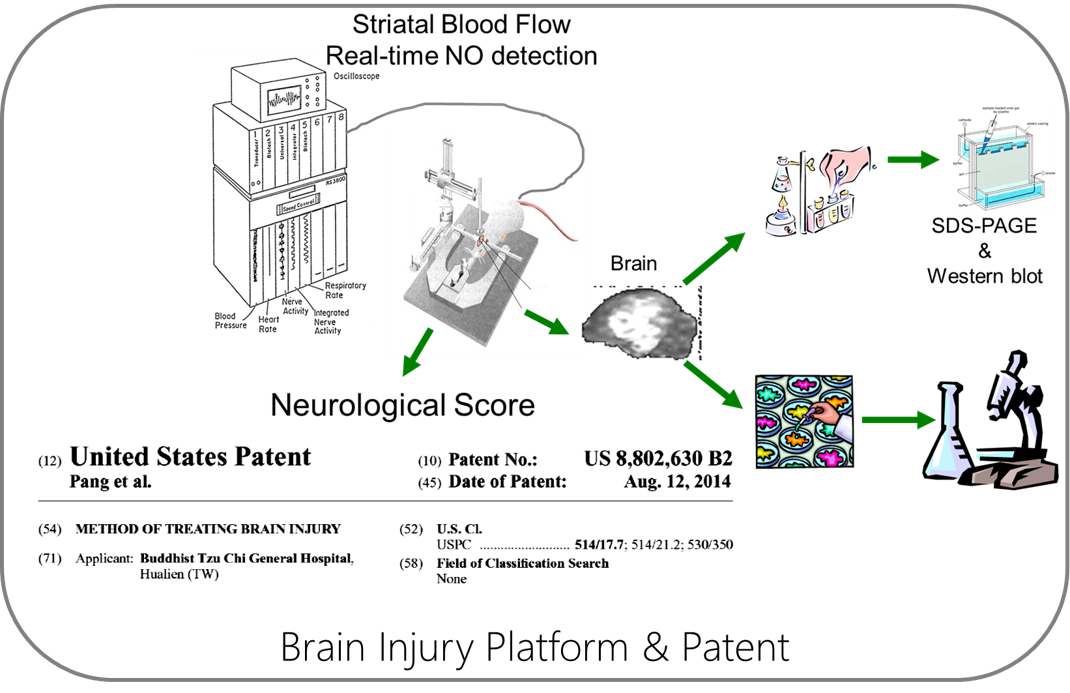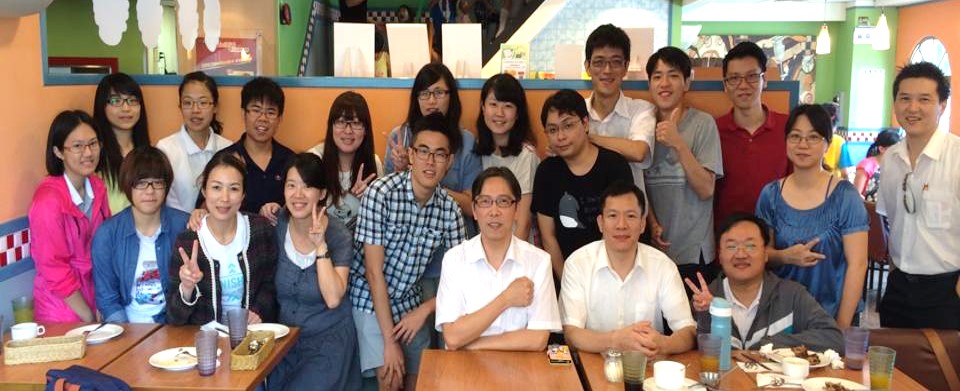 |
Dr. Pang, Cheng-Yoong | |
| E-mail:Email住址會使用灌水程式保護機制。你需要啟動Javascript才能觀看它 | ||
| Ext:15613 | ||
| National Yang Ming University, Taiwan. Ph.D. | ||
|
Expertise:Translational Medicine、Mitochondria、Stem Cell Regeneration Medicine |
Interest:
|
Our laboratory focus on developing and evaluating the effects of various mesenchymal stem cells transplantation on the outcome of brain injuries, spinal cord injury, Parkinson’s disease, and etc.. We have successfully launched a Phase I/II trial evaluating intracranial transplantation of autologous CD34+ bone marrow stem cells in patients suffering from chronic ischemic cerebral stroke. The trial has performed 6 transplantations, and the result has so far proven the safety and feasibility of intracranial delivery of stem cells, prepared in our GMP facility. Besides stem cell research, we are also interested in studying the protection mechanisms of growth factors (e.g., G-CSF), neuropeptides (e.g., urocortin), and herbal extracts on cellular damage caused by oxidative stress, neuro-degeneration diseases, and neurotrauma. |
Publication (in five years):
|
1. |
Tsai S, Chu S, Liu S, Pang C, Hou T, Lin S, Chen S. (2016, Dec). Neuroprotection of Granulocyte Colony - Stimulating Factor for Early Stage Parkinson’s Disease.. Cell Transplant., doi: 10.3727/096368916X694247.. (SCI).. |
|
2. |
Tseng TL, Chen MF, Liu CH, Pang CY, Hsu YH, Lee TJ*. (2016, Apr). Induction of endothelium-dependent constriction of mesenteric arteries in endotoxemic hypotensive shock.. Br J Pharmacol., 173(7):1179-95.. (SCI, 24/255 (Pharmacology & Pharmacy)). |
|
3. |
Liew HK, Cheng HY, Huang LC, Li KW, Peng HF, Yang HI, Lin PB, Kuo JS, Pang CY*. (2016, Jan). Acute Alcohol Intoxication Aggravates Brain Injury Caused by Intracerebral Hemorrhage in Rats . Journal of Stroke and Cerebrovascular Diseases, 25(1),15–25. (SCI, 194/252, NEUROSCIENCES ). 本人為通訊作者. |
| 4. |
Chen TT, Wu LS, Hsu PW, Pang CY, Lee KM, Cheng PC, Peng SY*. (2015, Aug). Mitochondrial dynamics in the mouse liver infected by Schistosoma mansoni.. Acta Trop., 148:13-23.. (SCI, 13/36, PARASITOLOGY). |
| 5. |
Chiu SC, Lin YJ, Huang SY, Lien CF, Chen SP, Pang CY, Lin JH, Yang KT*. (2015, Jul). The Role of Intermittent Hypoxia on the Proliferative Inhibition of Rat Cerebellar Astrocytes.. PLoS One., 10(7):e0132263.. (SCI, 8/56, MULTIDISCIPLINARY SCIENCES). |
| 6. |
Liew HK, Kuo JS, Wang JY, Pang CY* (2015, Jun). Granulocyte-Colony Stimulating Factor Increases Cerebral Blood Flow via a NO Surge Mediated by Akt/eNOS Pathway to Reduce Ischemic Injury. The Scientific World Journal, 2015:657932. (SCI, 16/55, MULTIDISCIPLINARY SCIENCES). MOST 96-2320-b-016-014-my3. 本人為通訊作者. |
| 7. |
Huang HY, Chiu TL, Chang HF, Hsu HR, Pang CY, Liew HK, Wang MJ.* (2015, May). Epigenetic Regulation Contributes to UrocortinEnhanced Midbrain Dopaminergic Neuron Differentiation. Stem Cells, 33(5):1601-17. MOST 101-2320-B-303-001. |
| 8. |
Liew HK, Huang LC, Yang HI, Peng HF, Li KW, Tsai AP, Chen SY, Kuo JS, Pang CY*. (2015, May). Therapeutic effects of human urocortin-1, -2 and -3 in intracerebral hemorrhage of rats.. Neuropeptides., pii: S0143-4179(15)00055-4. (SCI, 68/128, ENDOCRINOLOGY & METABOLISM). 本人為通訊作者. |
| 9. |
Li CJ, Sun LY, Pang CY*. (2015, Apr). Synergistic protection of Nacetylcysteine and ascorbic acid 2-phosphate on human mesenchymal stem cells against mitoptosis, necroptosis and apoptosis.. Sci Rep., 24;5:9819.. (SCI, 5/56). 本人為通訊作者 |
| 10. |
Chou CL, Pang CY, Lee TJ, Fang TC*. (2015, Mar). Beneficial effects of calcitriol on hypertension, glucose intolerance, impairment of endotheliumdependent vascular relaxation, and visceral adiposity in fructose-fed hypertensive rats.. PLoS One., 10(3):e0119843.. (SCI, 8/56, MULTIDISCIPLINARY SCIENCES). |
| 11. |
Chiu SC, Huang SY, Chang SF, Chen SP, Chen CC, Lin TH, Liu HH, Tsai TH, Lee SS, Pang CY, Hsieh TF. (2014, Sep). Potential therapeutic roles of tanshinone IIA in human bladder cancer cells. Int J Mol Sci, 15(9):15622-15637. (SCI, 52/148, CHEMISTRY, MULTIDISCIPLINARY). 本人為通訊作者. |
| 12. |
Li-Yi Sun, Dian-Kun Li, Pao-Jen Chen, Yu-Yu Joyce Ho, Jon-Son Kuo, Ching-Feng Cheng, Kuei-Fang Lee, Yao-Jen Chang and Cheng-Yoong Pang (2014, Apr). Expansion of Semi-Automatic Processed Human Adipose-Derived Stem Cells in Medium Supplemented with Autologous Serum and Antioxidants. J Stem Cell Res Ther, 4: 193. . 本人為通訊作者 |
| 13. |
Chiu SC, Huang SY, Chen SP, Su CC, Chiu TL*, Pang CY*. (2013, Dec). Tanshinone IIA inhibits human prostate cancer cells growth by induction of endoplasmic reticulum stress in vitro and in vivo. Prostate Cancer and Prostatic Diseases, 16(4), 315-322. (SCI, 20/77, UROLOGY & NEPHROLOGY; 94/203, ONCOLOGY). 本人為通訊作者. |
| 14. |
Pang CY, Chiu SC, Harn HJ, Zhai WJ, Lin SZ, Yang HH. (2013, Sep). Proteomic-based identification of multiple pathways underlying nbutylidenephthalide-induced apoptosis in LNCaP human prostate cancer cells. Food and Chemical Toxicology, 59, 281-288. (SCI, 21/123, FOOD SCIENCE & TECHNOLOGY; 34/87, TOXICOLOGY). 本人為第一作者. |
| 15. |
Sun LY, Pang CY, Li DK, Liao CH, Huang WC, Wu CC, Chou YY, Li WW, Chen SY, Liu HW, Chang YJ, Cheng CF. (2013, Aug). Antioxidants cause rapid expansion of human adipose-derived mesenchymal stem cells via CDK and CDK inhibitor regulation. Journal of Biomedical Science, 20(1), 53. (SCI, 49/124, MEDICINE, RESEARCH & EXPERIMENTAL). 本人為第一作者. |
| 16. |
Liao CH, Chen SY, Kuo JS, Pang CY. (2013, Jun). Reduction of Motor Disorder in 6-OHDA-Induced Severe Parkinsonism Rats by Post Treatment with Granulocyte-Colony Stimulating Factor.. Chinese Journal of Physiology, 56(3), 147-154. (SCI, 65/81, PHYSIOLOGY). 本人為通訊作者. |
| 17. |
Chuang JY, Liew HK, Pang CY, Kuo JS (2013, Mar). Size-controllable striatal lesion model for evaluation of neuroprotective agents in rats.. Tzu Chi Medical Journal, 25(1), 23-28. |
| 18. |
Chou CL, Pang CY, Lee TJ, Fang TC. (2013, Feb). Direct renin inhibitor prevents and ameliorates insulin resistance, aortic endothelial dysfunction and vascular remodeling in fructose-fed hypertensive rats.. HYPERTENSION RESEARCH, 36(2),123-128. (SCI, 26/65, PERIPHERAL VASCULAR DISEASE ). |
| 19. |
Yang JR, Liao CH, Pang CY, Huang LL, Chen YL, Shiue YL, Chen LR. (2013, Feb). Transplantation of porcine embryonic stem cells and their derived neuronal progenitors in a spinal cord injury rat model.. Cytotherapy, 15(2), 201-208. (SCI, 45/165, BIOTECHNOLOGY & APPLIED MICROBIOLOGY). |








